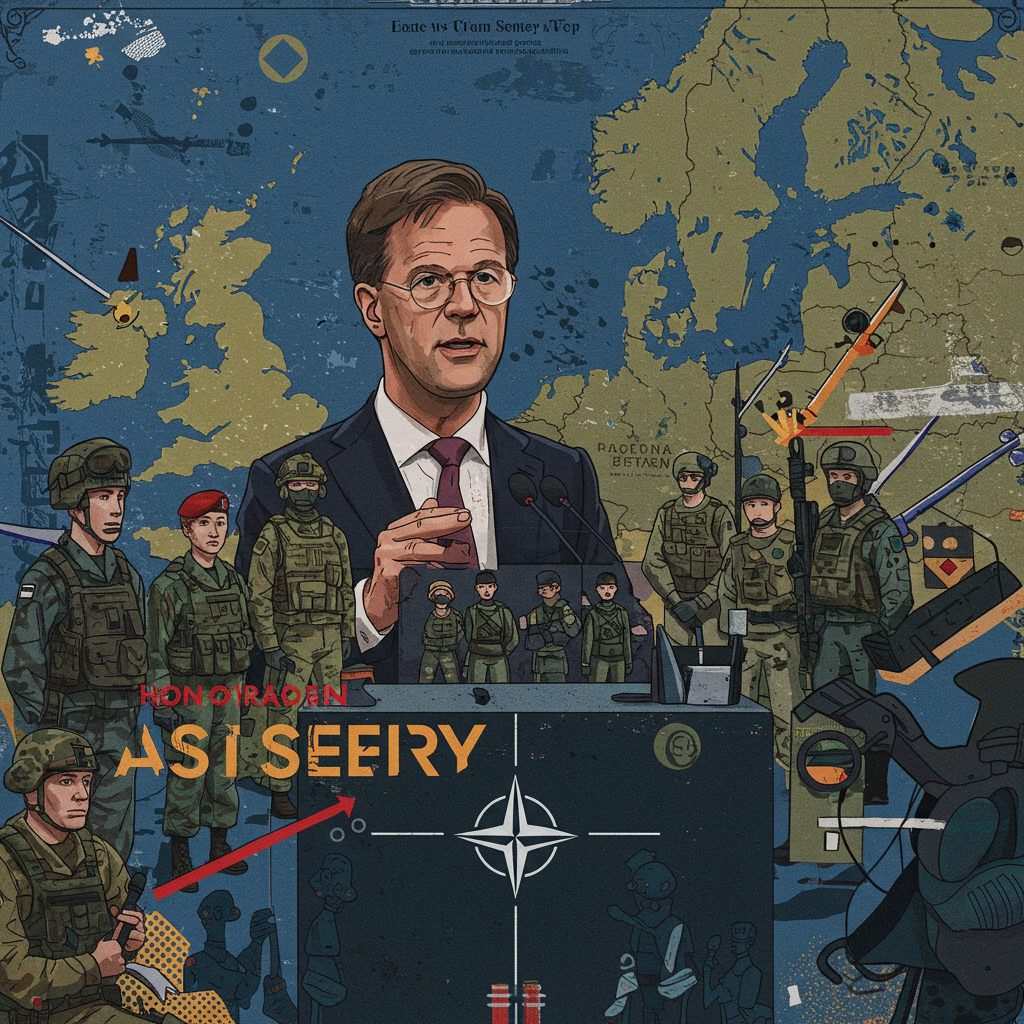In a significant move to reinforce its eastern borders, NATO has swiftly launched “Eastern Sentry,” a robust new military operation. This critical initiative comes in direct response to an unprecedented Russian drone incursion into Polish airspace on September 10, 2025. Aimed at bolstering defenses and demonstrating unwavering collective resolve, Eastern Sentry underscores NATO’s adaptability in the face of escalating aerial threats. The mission, announced by Secretary General Mark Rutte and Supreme Allied Commander Europe (SACEUR) General Alexus Grynkewich, signals a pivotal moment for European security, cementing the alliance’s commitment to protecting every inch of its territory.
The Unprecedented Incursion: Russia’s Reckless Drone Attack on Poland
The catalyst for Eastern Sentry was a profound violation of Polish airspace. On Wednesday, September 10, 2025, more than two dozen Russian drones breached Poland’s borders, marking what NATO Secretary General Rutte described as “the largest concentration of violations of NATO airspace” to date. The incursion, which lasted approximately seven hours through the night, saw Polish forces engaging and successfully downing multiple drones. While no casualties were reported, one home in eastern Poland sustained damage, highlighting the tangible risks of such incidents.
Polish officials reacted with immediate and strong condemnation. Prime Minister Donald Tusk vehemently dismissed suggestions that the incident was accidental, stating unequivocally, “We would also wish that the drone attack on Poland was a mistake. But it wasn’t. And we know it.” This firm stance directly countered initial remarks by then-US President Donald Trump, who initially appeared to downplay the event. The gravity of the situation prompted Warsaw to request urgent “consultations” under Article 4 of the NATO treaty, a clause invoked when a member’s territorial integrity, political independence, or security is at risk.
Eastern Sentry: NATO’s Swift and Comprehensive Response
NATO’s response was decisive and immediate. Secretary General Mark Rutte and General Alexus Grynkewich jointly announced the launch of Eastern Sentry, with initial operations commencing in the coming days. The mission is designed to enhance the alliance’s defensive posture, adding crucial flexibility and strength along its eastern flank. Rutte emphasized that regardless of intent, Russia’s actions were “dangerous and unacceptable,” demonstrating increasing “recklessness in the air” along NATO’s borders.
General Grynkewich elaborated on the strategic intent behind Eastern Sentry. He characterized it as an “entirely new defense design,” moving beyond fragmented, case-by-case responses to a more comprehensive and integrated approach. This new strategy incorporates lessons learned from the ongoing conflict in Ukraine, focusing on advanced sensors, kinetic, and non-kinetic weapons to counter evolving drone and missile threats. Eastern Sentry is flexible and agile, delivering more focused deterrence and defense precisely where and when needed. It builds upon previous initiatives like “Baltic Sentry,” launched earlier in 2025, to address specific regional vulnerabilities.
Allied Contributions Bolstering Eastern Sentry’s Might
The Eastern Sentry mission is a testament to NATO’s collective strength, with multiple allied nations committing significant military assets. Key contributions include:
Denmark: Two F-16 fighter jets and an anti-air warfare frigate.
France: Three Rafale fighter aircraft.
Germany: Four Eurofighter aircraft.
United Kingdom: Additional “assets” to reinforce the eastern flank.
These deployments, alongside enhanced ground-based air defense capabilities and increased information-sharing, are crucial for “plugging gaps in the line” and providing a more cohesive defense against sophisticated aerial incursions. The integration of these advanced capabilities ensures NATO remains prepared for any contingency, demonstrating its readiness to act as a truly defensive alliance.
Why the Eastern Flank Matters to ALL of NATO
A critical insight highlighted by NATO leadership is the interconnectedness of the entire alliance, particularly concerning the eastern flank. Secretary General Rutte dismissed the idea of “eastern flank thinking,” arguing that it fosters a false sense of security for nations further west. He explained that modern Russian missiles, traveling at hypersonic speeds, could reach cities like Madrid or London only minutes after impacting Tallinn or Vilnius. “Within this alliance for 32 countries, we all live on the eastern flank,” Rutte asserted.
General Grynkewich reinforced this perspective, stating that the eastern flank serves as a “first line of defense.” If threats successfully penetrate this critical zone, they could endanger the “entire alliance,” posing risks to NATO members far beyond the immediate border states. This strategic understanding underscores why Eastern Sentry’s scope extends beyond Poland, aiming to dynamically adjust and cover the entire eastern flank, “from the high north to the Black Sea and the Mediterranean.” Previous Russian drone violations in Romania, Estonia, Latvia, and Lithuania further underscore the pervasive nature of this regional threat.
Global Reactions and Geopolitical Context
The Russian drone incursion and NATO’s subsequent launch of Eastern Sentry triggered a wave of international reactions. Polish Prime Minister Tusk’s unequivocal condemnation was echoed by other European leaders. Germany and France, in a unified display of protest, summoned Russian ambassadors to their respective foreign ministries, describing the airspace violations as “unacceptable” and a “threat to the security of Europe and NATO.” An emergency UN Security Council meeting was also convened to discuss the escalating tensions.
Meanwhile, the European Union continued its strong stance against Russian aggression by extending sanctions against hundreds of Russian officials, oligarchs, and military commanders involved in the war in Ukraine. Russia, for its part, maintained that its forces were attacking Ukraine at the time of the incursion and had no intention of hitting targets in Poland, with Kremlin statements indicating Russia-Ukraine talks were “on pause.” While former US President Donald Trump’s initial comments caused some friction, Rutte expressed satisfaction with the ultimate American reaction and reaffirmed the US’s “ironclad” commitment to NATO. General Christopher Mahoney, a key US nominee, also later suggested the incursion “looks more intentional than not,” reflecting a hardening consensus.
The Evolving Threat of Drone Warfare and NATO’s Adaptation
The incident in Poland, and the subsequent launch of Eastern Sentry, vividly illustrate the critical and evolving role of drone warfare in contemporary military conflicts. The sheer volume and depth of the Russian incursion represented a new level of threat that demanded a proactive and adaptive response. NATO’s new defense design under Eastern Sentry is a direct acknowledgment of this shift.
This mission is not merely about increasing troop numbers; it is about fundamentally re-evaluating and upgrading defense strategies to counter sophisticated drone technology. By integrating advanced air and ground-based defenses, bolstering counter-drone capabilities, and enhancing information sharing, NATO aims to effectively deter future incursions and protect its airspace. The alliance’s rapid adjustment demonstrates its commitment to remaining agile and responsive to the dynamic geopolitical landscape and the ever-changing nature of modern warfare.
Frequently Asked Questions
What specifically triggered NATO’s Eastern Sentry mission?
NATO’s Eastern Sentry mission was directly triggered by a significant Russian drone incursion into Polish airspace on September 10, 2025. This event was characterized as “the largest concentration of violations of NATO airspace” by Secretary General Mark Rutte. Over two dozen Russian drones entered Polish territory, with some being shot down by Polish forces. The unprecedented scale and nature of this violation, coupled with ongoing Russian “recklessness in the air” along the eastern flank, prompted NATO to launch a new, robust defense operation.
Which NATO allies are contributing assets to Eastern Sentry?
Several key NATO allies are contributing substantial military assets to the Eastern Sentry mission to bolster defenses along the eastern flank. These include Denmark, providing two F-16 fighter jets and an anti-air warfare frigate; France, contributing three Rafale fighter aircraft; and Germany, deploying four Eurofighter aircraft. The United Kingdom is also committing additional assets. These contributions underscore the alliance’s collective commitment to reinforcing its posture with integrated air and ground-based defenses.
How does Eastern Sentry protect the entire NATO alliance, not just the eastern flank?
Eastern Sentry protects the entire NATO alliance by establishing a robust “first line of defense” along the eastern flank. Secretary General Mark Rutte explained that modern Russian missiles could reach Western European cities like Madrid or London only minutes after impacting eastern cities like Tallinn or Vilnius. Therefore, defending the eastern flank is crucial for the security of all 32 member states. General Alexus Grynkewich emphasized that any threats breaching this initial defense could endanger the entire alliance, making Eastern Sentry’s comprehensive strategy vital for collective security.
Conclusion: A United Front for European Security
The launch of Eastern Sentry marks a resolute and unified declaration from NATO. It clearly communicates the alliance’s determination to uphold its collective defense principles and adapt to evolving threats. The unprecedented Russian drone incursion into Poland served as a stark reminder of the volatile geopolitical climate and the critical importance of a robust, integrated defense strategy. By deploying advanced assets, refining its defense design, and reinforcing its eastern flank, NATO is not only protecting its immediate borders but safeguarding the security of all its members. This decisive action underscores the alliance’s unwavering commitment to peace through strength and vigilance in a complex world. Readers interested in European defense strategies and the future of drone technology should remain informed about these critical developments.



